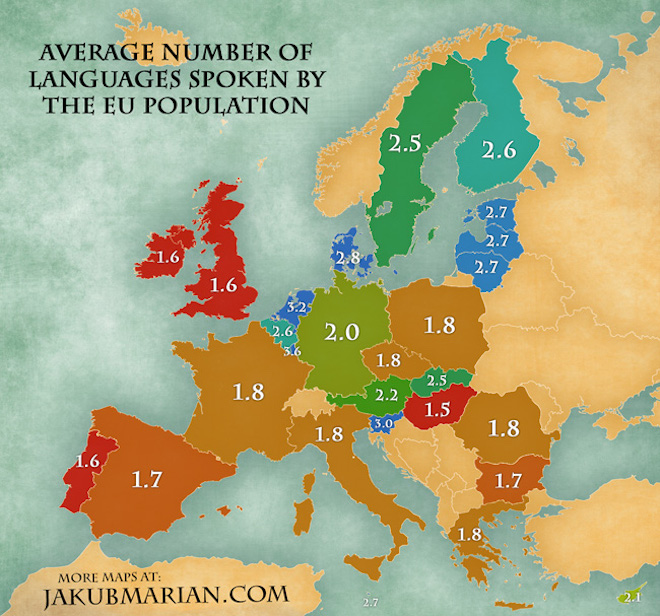The survey data sourced to make this map was based on participants self-reporting their language abilities instead of more precise testing. So, some individuals may have downplayed their linguistic abilities while others may have been boasting. These variables aside, however, the map is a provocative conversation starter.
In comparison, most statistical data in Canada centres around the distribution of bilingualism in French and English. According to the last Canadian census, from 2016, 17.9 percent of the population is bilingual. Most of the population (75.4 percent) speaks English as their first official language and 22.8 percent speak French as their first official language. It goes without saying that the ability to speak languages beyond English and French abounds in Canada. If a similar Eurobarometer-style survey was done in Canada, I would predict the average number of languages spoken by Canadians to be around 1.8, due to languages spoken at home with family and immersion school programs.
The factors that create a multilingual populace vary, though. Languages can be tools we take for granted, springing from one's cultural background and peers, as in the case of speaking Estonian at home or at community events. Hearing a combination of languages may result in variants like “Estonglish”, thought it wouldn't be regarded as a separate language.
Fragments of a language may enter our minds with less planning when we travel somewhere new and need to communicate for survival. For example, if you learn Greek to order meals when on a vacation. People seek to learn languages deliberately for social reasons, like getting closer to your significant others' family members.
Professional reasons are a form of language fuel, too. In Canada, think about how many job board postings a new graduate will come across that show favour to applicants with French-English bilingual abilities. If you didn't realize you would need that skill before, it could impede the advancement of your career. Likewise, cobbling together phrases for a business meeting can leverage better business negotiations abroad. These kinds of skills enable us to build rapport with customers and clients, but it's really not easy to gain them the fuller your plate gets as you grow older. It's no wonder some kids are given headphones to listen to audio language courses as toddlers. As we get older, speaking other languages becomes a badge of pride for how clever or productive you are. This comes back to educational systems' admiration for memorization. If you memorized it, you must have put in the sweat equity to keep it there and your brain must be well organized.
Speaking to relatives and friends in Estonia, there is a casual demeanour surrounding the ability to speak Estonian, Russian, and English. It's like the language “starter pack.” On top of that, they may have learned a fair bit of Latvian when on a road trip, a bit of Finnish after that camping trip one summer, or German from high school. I wonder if Estonians all agreed to be modest for language surveys and understate their skills…
Beyond tests like the Common European Framework of Reference for Languages (CEFR) exam, the gauge of fluency is wishy washy. Our perception of what “acquiring” a language looks like has changed, and that can have an influence on survey results.
30 years ago, it would be easy to use the label of Estonia as a crossroads to explain the country's multilingualism. Slovenia could also be used to push this idea, being between Austria, Croatia, Hungary, and Italy. Luxembourg is bordered by Belgium, France, and Germany. Scrutinizing the highest numbers on Jakub Marian's map, I wish Switzerland were added (even though it's not part of the EU), to see how German, French, Italian, and Romansh would rack up their average.
The ubiquitous nature of English as an international language of commerce and tourism likely reduces the multilingual abilities of a country like Estonia, because it makes it easier to speak with the whole world than with any other language. There are less opportunities to speak and practice other languages. However, Estonia's geographical position is only part of what fuels Estonian multilingualism. Estonia and Canada's PISA educational attainment rankings of fifth and sixth place in the world in 2018 show an overall high quality of schooling that would promote multilingualism. More than anything from the past, striving for intellectual curiosity and literacy in all nations would make these numbers high.
Written by Vincent Teetsov, Toronto




